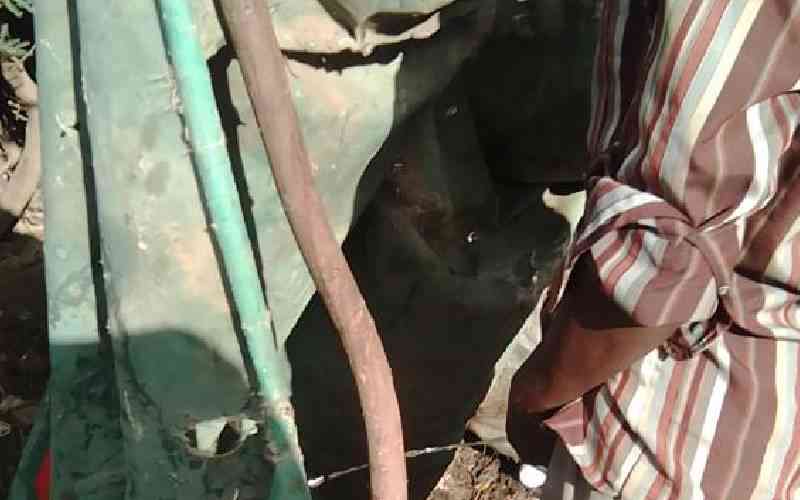Though Kenya’s Open Defacation(OD) rate declined from 16.2 per cent in 2003 to 7 per cent in 2022, the country remains among 36 countries still grappling with this unhealthy practice.
The 2019 Kenya Population Housing and Census Report (KPHC) revealed that 85 per cent of open defecation occurs in counties such as Turkana, Samburu, Marsabit, Wajir, West Pokot, Garissa, Kwale, Narok, Kilifi, Baringo, Mandera, Kajiado, Homa Bay, Isiolo, and Tana River, where at least 50.2 per cent of the population practices open defecation.
Interestingly, Tana River’s 50.2 per cent residents are part of 4.76 million Kenyans among the 419 million people globally practicing open defecation.
“With larger populations and more established economies like India and Nigeria showing higher OD rates, Kenya’s 7 per cent rate seems modest and on the right track,” said Mohamed Mukabwa.
However, only 60 per cent of Kenyans have access to safe drinking water, and 29 per cent have access to basic sanitation.
This shortfall in basic sanitation has prompted the Kenya Sanitation Enabling Environment Project (KSEEP) and the Kenya Water for Health Organization (KWAHO) to partner in the ambitious goal of providing adequate sanitation and hygiene to Kenyan households by the end of 2025.
Another daunting target is the United Nations Sustainable Development Goals (SDGs), which call on Kenya to achieve the same sanitation goal by 2030.
Despite these efforts, with an increasing population and little progress in the 15 high-burden counties, Mukabwa remains skeptical.
He laments that counties like Turkana still have a 72 per cent open defecation rate, despite numerous interventions.
“Apparently, KWAHO, KSEEP, and SDG goals will remain unmet in these high-burden counties,” Mukabwa said, questioning why open defecation persists.
Stanley Kabwe, proprietor of Makuti Lodge in Mororo Township, Tana County, offers insights into the practice. He cites the lack of latrines and the use of available space for other purposes, like bathing, as major factors.
Kabwe also says the issue of exclusion in certain cultural societies, where women are forbidden from eating or sharing toilets with men. “As a result, women are forced to use dangerous open defecation areas, where they risk snake and scorpion bites, among other dangers.”
Interestingly, Ibrahim Maalim in Garissa explains that some people cherish open defecation as a way of interacting with nature.
Stay informed. Subscribe to our newsletter
“Despite having a toilet at home, some people still prefer open defecation,” Maalim observes.
He adds that for them, it’s a form of social interaction, offering a sense of airy freedom. People often chat happily while engaging in the practice.
However, he regrets that poor housing, often lacking latrines, leads to a lack of privacy, particularly for women during menstruation.
In Mandera, social observer Nuria Mohammed justifies open defecation in water-scarce, nomadic pastoralist societies. “We are yet to own portable toilets for our daily needs,” she explains.
However, Garissa University Environmental Science lecturer Dr Mohamud Hashi dismisses the comforting notion that Kenya’s 7 per cent open defecation rate is modest and harmless.
“Given the health risks and the environmental impact of faecal contamination, achieving zero open defecation must remain our goal,” Hashi emphasized.
Social worker Florence Musomba recalls a disturbing case of sexual exploitation in Kilifi that resonated widely. She says that while open defecation may be the norm in Kilifi and other areas, the increase in sexual exploitation is not.
“Such cases breach social norms and Gender-Based Violence (GBV) rules,” she stated with conviction.
“Unlike many women who end up sexually exploited, infected with Sexually Transmitted Diseases (STDs), or dealing with unwanted pregnancies during such bush assaults, the lady escaped physically unharmed but suffered psychological trauma,” Musomba explained.
Privy to similar distressing reports, Fatuma Kinzi Abass of Garissa Pastoralist Initiative (PGI) comments that women’s social needs remain unmet in the affected counties, where schoolgirls often drop out for similar reasons.
“Sadly, the women who suffer live with diseases, injuries, unwanted pregnancies, and the stigma of the vice, while male offenders walk scot-free,” she said.
Saddened by the near futile efforts to reduce open defecation and its severe consequences on women in the 15 mainly nomadic pastoralist counties, Kinzi calls on women to speak up.
“Without that, we can’t make progress or break even,” she appealed.
In Tana County’s Mororo township, former administrator Mohamed Lokha revealed that the area has only 104 makeshift pit latrines shared by 10,799 residents across 1,078 households.
The Kenya Population and Housing Census (KPHC) 2019 report adds that 2.8 per cent of Tana residents dump human waste in the streets, and 2.9 per cent use pit latrines.
Social worker Beatrice Mutinga attributes Tana’s toilet scarcity to poverty and a cultural belief that “jinni” (evil spirits) reside in toilets.
Kololo Gutu, a Garsen town resident, confirmed, saying, “Without enough to eat, why would I dig an expensive, devil-inhibiting toilet that bewitches my family?”
In a related concern, Lokha warned that Tana’s groundwater is only accessible within 7 feet of the surface.
“So, residents should dig latrines sparingly to prevent human waste from contaminating the groundwater and boreholes we rely on for domestic use,” he cautioned.
Sadly, the Tana River County Standardization Monitoring Assessment Relief and Transition (SMART) Survey Report, June 2022, reveals that only 17 per cent of households treat their water.
Mutinga highlights the troubling data on untreated water usage, which paints a grim picture of the disease burden on those relying on untreated water. Poor water storage and contaminated domestic water contribute to rampant fecal contamination.
According to UNICEF, a gram of feces contains 10 million viruses, one million bacteria, and a thousand parasitic cysts, which raises concerns for Garissa Level Five Hospital’s Dr Ahmad Yussuf.
He explains that open defecation pollutes soil and water, spreads flies, and contaminates food, leading to various infectious diseases such as hookworm, ascariasis, cholera, dysentery, typhoid, parasitic worm infections, bilharzia, and even viral diseases.
“Walking barefoot or wearing open shoes in areas severely affected by open defecation exposes residents to soil-transmitted worms and bacterial infections, resulting in diarrheal diseases,” Yussuf adds.
He warns that diarrheal infections not only weaken adults, reducing their economic productivity, but also affect lactating mothers, who can offer little to their infants, leaving children with multiple intestinal infections.
After rains and floods, disease-carrying vermin and insects breed in fecal-contaminated stagnant water, creating fertile grounds for disease.
The SMART report identifies chronic food insecurity, inadequate dietary diversity, poor hygiene, and limited access to safe water and sanitation as key drivers of poor nutritional status in Tana County.
Open defecation and environmental factors also spread other communicable diseases. The region’s few clinics, widespread self-medication, overreliance on traditional therapists, and lack of awareness remain major barriers.
Despite these challenges, Abdullahi Mohamed, CEO of Womankind Kenya, is hopeful. The NGO, which partners with the Northeastern and Tana County governments, works to achieve an Open Defecation Free (ODF) status.
“We regularly sensitize communities, schools, and Community Health Volunteers to create attitude and behavioral change,” says Mohamed. Achieving ODF status in villages like Bulla and Iftin in Garissa has triggered nearby communities to follow suit.
However, human rights activist Kantona Dadosa feels that open defecation reduction isn’t taken seriously. He blames public health officers for their lack of urgency, saying, “They are slow, with haphazard implementation of policy guidelines.”
A public health officer in Tana anonymously responded, stating, “Poor road networks make access to these areas difficult, but we do our best to reach the people.”
Tana River Health, Sanitation, and Medical Services executive Joshua Jarha urges residents to change their habits despite their strong attachment to open defecation.
“Our facilitators are working to sensitize and educate the public on the health risks of unsanitary practices, including the dangers of open defecation,” he says.
Jarha also calls for external funding to build toilets and reduce the open defecation burden.
Despite the high prevalence of open defecation in Tana (50.2%), the World Health Organization (WHO) notes a global decline. In 2017, there were 892 million people without toilets; by 2022, this number had dropped to 419 million, including Kenya’s 4.76 million.










